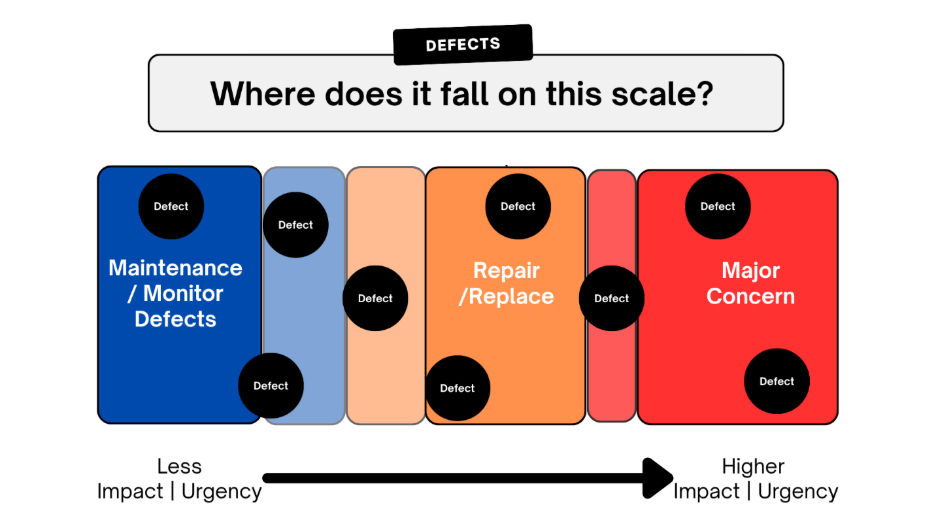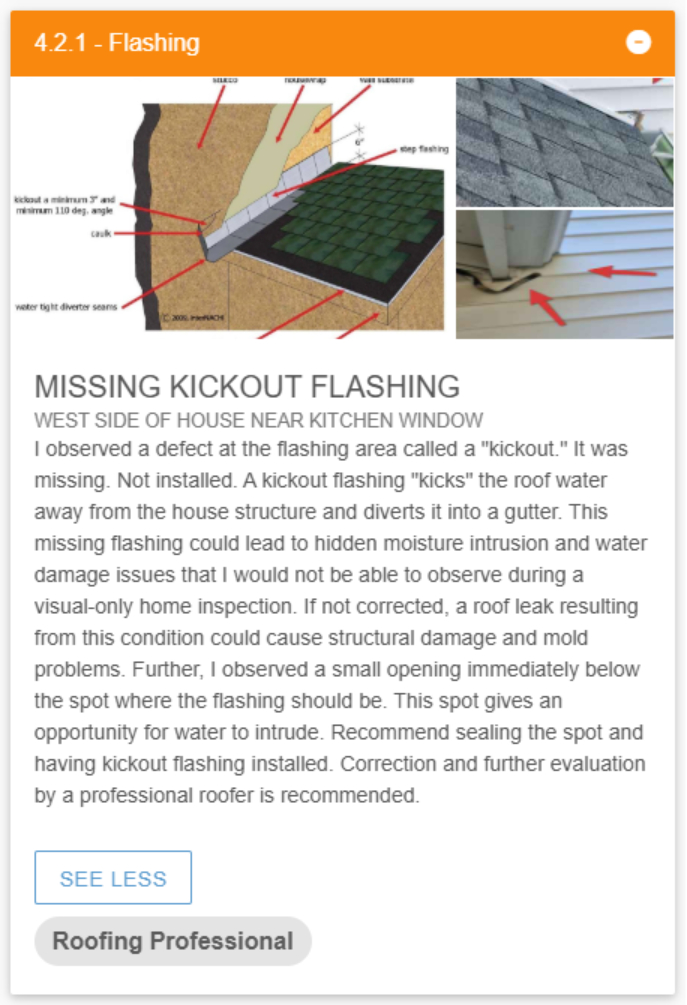Part 3 of a deep dive into Inspection Reports. This article focuses on Defects that require Repair or Replacement.
By: Sean Struckmeyer | Tech Inspect Home Services
This is part 3 of our deep dive series into our inspection reports. For this post, we’ll focus on the report categories of Repair/ Replace items.
To see more about the report in general, see Part 1 in the series.
Part 2 Covered Maintenance Items and Part 4 will cover ‘Major Concerns’.
When we left off, we had begun to unpack the defect sliding scale. This is even more important with the Repair/Replace Defects. This is a large category and where most observations will fall.
CONTEXT is Everything, Understanding the Fully is Important.
Context of the defect (the system/component where the defect is aligned, the severity of the defect) all come into play. However, there’s also the homeowners bias and what they are able/willing to accept is another factor that determines where a defect may fall on the sliding scale.
What do we mean by Homeowners Bias? Well, it means that homeowners may be willing to accept one defect but not another, maybe because they don’t see it as a big deal or maybe because they can fix it or are willing to live with it, and this bias will change person to person.
- Buyers have different budgets
- Buyers have different goals
- Buyers have different timelines
- Buyers have different risk tolerances
All the above factors play into the buyer’s perspective of where a defect falls within the repair/replace scale. The home inspector can only document what we observe, why this is or could be a problem and some recommendations for what to do about it.
So, we recommend that everyone keep this scale in mind and evaluate the defects accordingly. It may also be that after further evaluation from a contractor the defect may move around on the scale as more information is gathered, it could be of lesser or greater concern. Knowledge is power.

So, what are Repair/Replace Defects?
- Defects Requiring Repair or Replacement are color-coded in Orange
- A component may be at the end of its serviceable life cycle or no longer functioning as expected.
- A component that is not installed properly or missing altogether.
- Issues that may need professional repair or replacement. It’s best to consult a recommended contractor.
Repair/Replace – Example:
The following is a real example and one that comes up often. There is missing drip edge flashing on the roof eaves and rakes. Drip edge flashing is important to help protect the roof sheeting and fascia boards from water and is often found to be, not installed (probably to save money).
From a homeowner’s perspective, you need to consider the age of the roof. If it’s nearing the end of its service life, then you might decide this can wait and have the drip edge flashing installed when the roof is replaced at a future date. If it’s a brand-new roof and this component is missing, then you may want to discuss options to have it installed sooner, rather than later.
This is a prime example of why defects need to be evaluated against the larger context of the home. Depending on the age of the roof and the budget of the homeowner, this may be a priority at the time of the inspection, or it might not, ultimately it’s up to the homeowner.
In this particular scenario, the roof sheathing is damaged, and the roof will need to be replaced (hail damage), so even though the roof is only a few years old, when everything gets replaced the homeowners should also have drip edge flashing installed around the roof’s perimeter. So, it’s not a thing that must be fixed ‘today’ but something that will need to be fixed, soon.

Another Example:
A home with a gable and soffit/ridge vent combination. This is an incorrect setup, therefore it should be repaired, however the homeowner may evaluate it within the context of the home and decide that since it does not currently seem to be causing issues, (no mold) and they are considering having the siding replaced, that blocking off the gable vents can wait until the siding is replaced. Again, looking at the singular defect in context of the home’s overall structure and plans for the home.

One Last Example:
Missing Kickout flashing, in this case, the homeowner may decide that this warrants more urgent attention and to have the missing flashing installed. In this situation, there has already been repair work performed at this location, so therefore, to prevent future issues and the need for additional repair, the homeowner may move this up as a higher priority within the context of the home and the inspection report’s findings and recommendations.

To Summarize:
Defects should not be viewed in isolated terms. They should be viewed in comparison to the home’s overall conditions, any adjacent defects that may be related, the homeowner’s budget, goals, and timelines.
Homeowners should be asking:
- Do I need to fix it now?
- Can it wait?
- Can it wait to be fixed as part of a larger project?
- Will it cause further issues if we don’t fix it right away? What does that timeline look like?
- If we aren’t going to permanently fix it, is there a temporary solution?
- Is this allowing water to get into my home?
- Do I have an active water leak?
- Is this managing water away from the home?
Important Note: From Tech Inspects perspective, anything that manages water or prevents water from entering the home (e.g. missing flashing, caulk, roof leaks, leaking pipes, defective gutters, site drainage, etc.) that is observed to be defective should be addressed with immediacy and greater urgency. Water can quickly damage a home and cause a variety of issues if left unchecked.
If you’re unsure, have a conversation with your inspector and get additional information from contractors, the more information you can gather, the more informed your decisions and contextual understanding will be.
